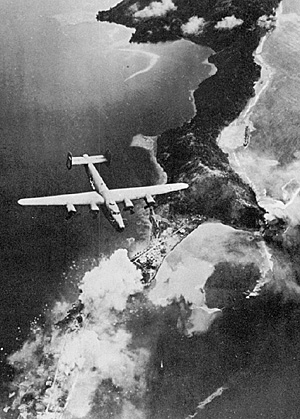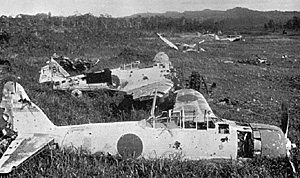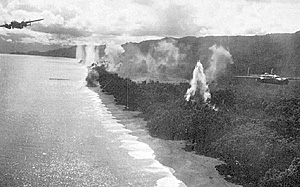Increases in Air Strength
The increases in Allied strength that had been promised to the Southwest Pacific Area at the Pacific Military Conference in March had been coming through practically on schedule. (This section is based on Craven and Cate, The Pacific: Guadalcanal to Saipan, pp. 168-86; Morison, Breaking the Bismarcks Barrier, pp. 257-61; Kenney, General Kenney Reports, pp. 251-79.)
P-47's of the 348th Fighter Group began arriving in Australia in June, and before the end of July the whole group had been deployed to New Guinea. The 475th Fighter Group, flying P- 38's, was ready for combat by the middle of the next month.
 Bomber strength, too, was increasing.
Newly arrived B-24s of the 380th Heavy
Bombardment Group went into action from
Darwin, Australia, in mid-July.
Bomber strength, too, was increasing.
Newly arrived B-24s of the 380th Heavy
Bombardment Group went into action from
Darwin, Australia, in mid-July.
B-24 over Salamaua, 13 Aug 1943. Smoke from bomb bursts.
One of the 380th's first large-scale operations was a spectacular raid on the oil center at Balikpapan, Borneo, on 13 August, a feat that required a 1,200-mile round trip. Port Moresby saw the arrival of new B-25's of the 345th Medium Bombardment Group in July. And the C-47's were also increasing in number. By September the 54th Troop Carrier Wing could boast fourteen full squadrons of transport planes.
By the end of August the Southwest Pacific Area had on hand nearly all its authorized plane strength--197 heavy bombers and 598 fighters. Keeping this number in flying condition, however, was next to impossible. Many of the planes were old, and with the air forces constantly in action there were always battle casualties. Kenney was always short of manpower; he could never obtain enough replacement pilots to keep all his new and veteran squadrons up to strength, a condition that was probably duplicated in every active theater.
Operations
The first important action of Kenney's Allied Air Forces in preparation for the Markham Valley-Huon Peninsula operation was the development of the staging fields in the Watut Valley and in the Ramu-Markham trough. Ever since the Buna campaign Kenney had been anxious for a good fighter field near Lae to use in coverin- the invasion. He hoped to fly troops into an existing emergency strip and seize it, as he had done during the Buna campaign, Kokoda and Wan had been surveyed but found unsuitable. Then in May an aviation engineer officer, with orders to find a field farther forward than Wan, trekked from the Bulolo Valey almost to Salamaual found nothing suitable, and thereupon backtracked and went down the Watut River where he found and recommended an emergency landing strip at Marilinan.
But Marilinan was not perfect; it was feared the September rains would render its clay too muddy to be usable. At this point General Wurtsmith of the V Fighter Command took a hand. Looking over the ground himself, he picked a site at Tsill Tsili four miles down the Watut River from Marilinan. Kenney and Whitehead agreed with his choice.
Meanwhile Kenney and Herring arranged to build the second staging field, using a few Australian troops and native labor, at Bena Bena south of the Ramu Valley. This emergency strip had long served as a New Guinea Force patrol base, and the Japanese at this time were hoping to capture it eventually. The Allies decided to build a grass strip suitable for fighters at Bena Bena (C-47's carrying supplies to the Australian patrols had been using Bena Bena for some time), and to burn off the grass in fashion so obvious as to distract the enemy's attention from Tsili Tsili.
In June and July, C-47's flew Australian troops and the U.S. 871st Airborne Engineer Battalion to Marilinan. The troops moved down the river to Tsili Tsili, cleared the strips, and C- 47's flew in specially designed bulldozers and other earth-moving equipment. Some gear, including trucks sawed in half so they could be loaded into C-47's, was also flown to Tsili Tsili, where the trucks were welded together. Two strips at Tsill Tsili were soon ready, and by midAugust three thousand troops, including a fighter squadron, were based there. Japanese aircraft failed to molest the Allies until the fields were all built; they raided Tsili Tsili on 15 and 16 August without doing much damage and thereafter left it alone.
While General Kenney had liked the prospects of Tsili Tsili from a technical point of view, he had felt that Tsili Tsili had an unfortunate sound. He therefore officially directed that the base be given the more attractive name of Marilinan. (Craven and Cate in The Pacific: Guadalcanal to Saipan, however, use the name Tsili Tsili.)
During this period the Fifth Air Force had been supporting the Allied diversionary attacks against Salamaua. Nearly every day of July saw some form of air attack against the Lae-Salamaua area. Sorties during the month totaled 400 by B- 25's, 100 by B-24's, 45 by RAAF Bostons, 35 by A-20's, 30 by B-17's, and 7 by B-26's. The Japanese supply point at Madang was also raided during the period 20-23 July by B-25's and heavy bombers.
 ENEMY AIRCRAFT DESTROYED ON THE GROUND by Allied planes near Lae.
ENEMY AIRCRAFT DESTROYED ON THE GROUND by Allied planes near Lae.
But these raids were secondary to Kenney's main air effort, which was directed against Wewak. Aware of the increase in Japanese air strength at Wewak, and lacking enough strength to hit both Wewak and Rabaul, Kenney had decided to concentrate against Wewak rather than Rabaul up to the day of the landing at Lae, and to rely in part on the Weather for protection against Rabaulbased planes. There were too many Japanese fighter planes at Wewak, however, for Kenney to risk sending unescorted bombers there. Raids against Wewak had to await completion of the Marilinan staging field, which would extend the range of Allied fighters as far as Wewak. Meanwhile Kenney ordered his bombers not to go as far as Wewak, thus leading the Japanese to believe that Wewak lay beyond bomber range and to send planes there with a false sense of security.
On 13 August photographs taken by Allied reconnaissance planes showed a total of igg Japanese airplanes on the four fields at Wewak. The 4th Air Army was now due for a surprise. Marilinan was ready by midmonth and so was the Fifth Air Force. General Whitehead had four bombardment groups with enough range to hit Wewak from Port Moresby -two heavy groups with 64 planes in commission and two medium groups totaling 58 B-25's. With Marilinan in commission the bombers would have fighter protection all the way.
 B-25 Medium Bombers leaving installations aflame in the Wewak area.
B-25 Medium Bombers leaving installations aflame in the Wewak area.
Heavy and medium bombers and fighters struck the four Wewak fields on 17 August and achieved excellent results. Taking the Japanese by surprise, they caught most of the enemy planes on the ground. Next day they were back in strength, and the Wewak offensive continued throughout the rest of August. The planes struck at Hansa Bay and Alexishafen during the same period.
Damage inflicted by these raids was heavy, though less than estimated at the time. Kenney's headquarters claimed over 200 Japanese aircraft destroyed on the around, a claim that Army Air Forces headquarters scaled down to 175. Postwar Japanese reports, however, give losses as about half what the Allies initially claimed. (8th Area Army Operations, Japanese Monogr No. 110 (OCMH), p. 83, states that one hundred planes were lost; 18th Army Operations, II, Japanese Monogr NO. 42 (OCMH), 29, asserts that sixty to seventy were destroyed.)
But despite the efforts of Imamura and Teramoto, strength of the 4th Air Army thereafter averaged but 100 planes, and "the prospect of the New Guinea operation [was] much gloomier." (8th Area Army Operations, Japanese Monogr No. 110 (OCMH), p. 84.)
The Allied Naval Forces, which had not played a decisive part in the Buna campaign because it lacked enough ships and because hydrographic information on the waters of New Guinea's north coast was almost nonexistent, was also taking a hand. PT boats based at Morobe were stalking the enemy barge routes at night and making the transport of men and munitions to Lae increasingly difficult. The Fifth Air Force's successful strike against Wewak encouraged Admiral Carpender to send warships as far up the coast as Finschhafen.
Thus on 22 August four destroyers under Capt. Jesse H. Carter left Milne Bay, stopped at Buna to discuss air cover and obtain target information, and sailed for Finschhafen. Starting at 0120, 23 August, Carter's ships bombarded Finschhafen with 540 rounds of 5-inch shells and returned safely to Milne Bay. This operation was small in itself, but it was significant because this was the first time Allied warships had ventured so far up the New Guinea coast.
During the first three days of September Allied planes executed preparatory bombardments in support of the Lae invasion. They launched heavy attacks against airfields, supply points, and shipping lanes on i September, the same day on which medium and heavy bombers raided Alexishafen and Madang. Next day B-25's and P-38's delivered a lowlevel attack against Wewak. Gasmata and Borgcn Bay on New Britain, and Lae itself, were struck on 3 September, and eleven nocturnal RAAF Catalinas raided Rabaul.
More Markham Valley and the Huon Peninsula
- Plans: US and Japanese
Allied Air and Naval Preparations
The Salamaua Attack
Lae: The Seaborne Invasion
Nadzab: The Airborne Invasion
Strategic Reconsiderations
The Coastal Advance
Jumbo Map: The Huon Peninsula (monstrously slow: 611K)
Back to Table of Contents -- Operation Cartwheel
Back to World War Two: US Army List of Issues
Back to MagWeb Magazine List
© Copyright 2002 by Coalition Web, Inc.
This article appears in MagWeb (Magazine Web) on the Internet World Wide Web.
Other military history articles and gaming articles are available at http://www.magweb.com